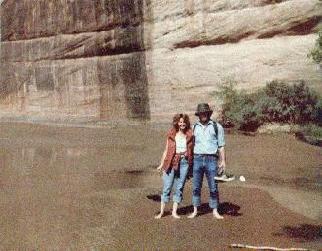


In the canyon walls can be read the traces of ancient, coastal sand dunes that covered this area a quarter of a billion years ago. These wind-blown sands were gradually compacted to form the De Chelly Sandstone, through which streams cut canyons up to a thousand feet deep. The two main canyons, Canyon del Muerto to the north, and Canyon de Chelly to the south, were carved by Tsaile Creek and Chinle Wash, respectively. These two streams flow generally toward the west, and eventually join each other at the town of Chinle at the western end of the monument.
The canyons are still inhabited during the summer months by about 30 families. For this reason, access to the canyon is restricted to overlooks along the rims, and a trail that descends to White House Ruin in the main canyon. Bus tours are available from monument headquarters, but hiking and horseback exploration are possible only by engaging an accredited guide.
 |
Spider Rock - so named after the legend of Spider Woman, who is credited with endowing the Navajo people with the craft of weaving. Spider Rock is roughly 800 feet high. Some sense of the scale involved can be obtained from the jeep trail to the left of the spire. |
|---|---|
 |
Antelope House Ruin - this was a pueblo of roughly 50 rooms and four kivas, built against the base of the north wall of Canyon del Muerto. It was inhabited during the Great Pueblo phase (AD 1100 - AD 1300). The ruin is named for four life-sized figures of antelopes painted by Navajo Indians to the west of the ruin. Note the black streaks on the cliff above the ruin; this is called desert varnish, a stain of manganese or iron oxide that occurs on many exposed desert cliffs. The mechanism by which these stains are produced is not definitely known. |
 |
This is a photo of Louise and me in Chinle Wash. We are at the bottom of the White House Ruin trail in Canyon de Chelly. Note the cross-bedding in the rock strata of the cliff behind us. This structure is the basis of the idea that the sandstone was deposited as wind-blown dunes during the middle of the Permian age. |